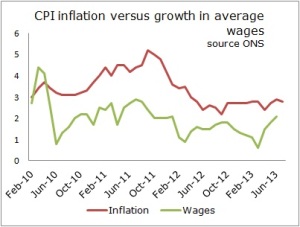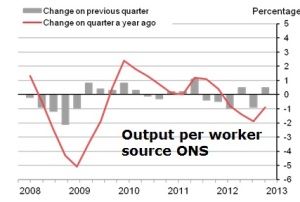 There are two big question marks hovering over the UK economy. The answers may determine whether the UK is seeing a temporary recovery or something a good deal more real.
There are two big question marks hovering over the UK economy. The answers may determine whether the UK is seeing a temporary recovery or something a good deal more real.
First consider the surveys. Every month Markit and CIPS get together to produce Purchasing Managers Indices (PMIs) covering UK manufacturing, construction and services. Then they add them all together and produce a composite index. Over the last few months these indices have been really rather exceptional. A couple of months back the composite PMI hit an all time high. Okay data only goes back to 1998, even so it was impressive stuff. Since then the PMIs have fallen back a tad, but they still remain way above historic averages.
Some economists reckon that the PMIs are consistent with quarter on quarter growth of around 1.5 per cent. To put that into perspective, there aren’t many emerging markets growing that fast.
But here is the thing, the hard data from the Office of National Statistics (ONS) is not so good. For the third quarter of last year the ONS had quarter on quarter growth at 0.8 per cent. That growth rate is good, compared to what we have become used to it is marvellous, but it was less than the level the PMIs were indicating.
As for Q4 of last year, the PMIs suggested that was even better than Q3. Alas, not so the data from the ONS, it had the economy growing by 0.7 per cent. Okay, that growth rate may get revised upwards, but it is still way down on what the PMIs suggest.
Drilling down, construction may provide a partial answer. The ONS had this contracting 0.3 per cent in the last quarter of last year, the PMIs had it surging to its highest level in several years. Since then the PMIs tracking construction have got even better. This suggests that the ONS will either revise its estimate of construction’s contribution to UK growth in Q4 upwards, or we will show a marked improvement in Q1.
The latest PMIs also point to the largest backlogs in orders within the services sector since May 2007. That seems to suggest we are either set to see the sector’s output surge, or we may get rising prices instead. Or both.
Then there is business confidence, in the services sector this rose to its highest level since 2012.
These days, it’s popular to talk about that elephant in the living room. You hear the phrase so often, that is a wonder there are any elephants left in the wild, so busy are they filling up our livings rooms. Well apologies for adding to living room congestion, but as far as the UK economy is concerned there are two elephants in the living room
Elephant number one is household debt/house prices. Part of the UK’s recovery is coming on the back of rising house prices, making households feel richer, encouraging them to spend more. This is not new, the idea that the government is repeating the mistakes that led to the finance crisis in the first place is rehearsed most days in the media, and indeed by politicians. Some deny it of course. But one piece of hard data needs to borne in mind. The fact is in Q3 of last year the savings ratio fell, this was the main contributor to growth. We haven’t got the data for Q4 yet. But given the imminent retirement of the baby boomers, is creating growth via less households savings really a good idea?
The other elephant in the living room is cash sitting on corporate balance sheets. If they could be persuaded to spend it, ideally invest it, the UK economy would boom like it hasn’t done for a very, very long time.
Just to remind you, according to the PMIs work backlogs are soaring, business confidence is rising, might that be enough to get companies spending again?






